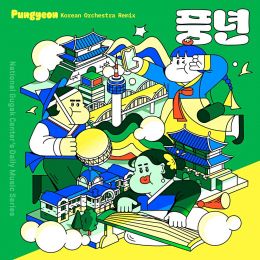(National Gugak Center’s Daily Music Series)
[Album Review]
국립국악원과 작곡가 양승환 협업 프로젝트의 일환으로 만들어진 Pungyeon (국악 관현악 Remix) 은‘풍요롭다’의 사전적 의미 ‘흠뻑 많아서 넉넉함이 있다’에서 비롯되었다. 오케스트라가 오케스트레이션에 맞추어 연주할 때 조화로운 앙상블을 이루 듯, 우리가 살아가는 세상, 삶에서의 풍년(풍요)도 마찬가지가 아닐까?
A collaborative project between the Gugak National Center and composer Seunghwan Yang, Pungyeon(Korean Orchestra Remix)developed from the meaning of the word “pungyo” in the dictionary: “an abundance from having plenty.” Just as an orchestra creates a harmonious ensemble by playing to the orchestration together, “pungyeon” (“pungyo”) has a similar function in our lives.
[Song Review]
01. 풍년 Pungyeon (Korean Orchestra Remix)
정악과 민속악, 정가와 판소리를 하나의 곡으로 부르는, 각기 다른 소리가 창법을 넘나들며 선율과 리듬을 오가며 조화로운 풍년을 노래한다. 피리와 양금의 내드름에 이어 관악기(소금, 대금, 생황 등)와 김준수(판소리), 현악기(25현 가야금, 거문고, 해금, 대아쟁 등)와 박진희(정가)의 음색이 대비되며 시작된다. 정박으로 이어가는 김준수의 힘 있고 유유한 소리에 박진희의 단아하고 청아한 음색이 어우러져 전혀 다른 음색과 창법이지만 이들이 만나 또 다른 개성과 매력을 확인하게 된다.
By combining classical music and folk music, jeongga and pansori into one song, different sounds weave through the melody and rhythm to sing about a harmonious bumper year. After the piri and yanggeum set the mood of the song, wind instruments (sogeum, daegeum, saenghwang, etc.) and Junsu Kim (pansori) and string instruments (gayageum, geomungo, haegeum, daeajaeng, etc.) and Jinhee Park (jeongga) create contrasting tones from the very beginning. As Junsu Kim’s powerful and unhurried singing blends with Jinhee Park’s delicate and clear voice, two completely different tones and techniques create an original, charming harmony.
━
Lyrics: Gonne Choi
Composition: Kyunghoon Park
Arrangement: Soungwhan Yang
Korean Orchestra: National Gugak Center
Voice: Junsu Kim, Jinhee Park
02. 풍년 Pungyeon (Korean Orchestra Remix) (Inst.)
━
Composition: Kyunghoon Park
Arrangement: Soungwhan Yang
Korean Orchestra: National Gugak Center
[Fictional Universe of 풍년 Pungyeon]
전작 ‘풍년 Pungyeon’(작곡 박경훈, 25현 가야금 박세연)(2020.12.21. 발매)이 가실왕이 우륵으로 하여금 만들게 했던 우륵의 12곡이었다면, 2023년 7월의 신작 풍년(Pungyeon Remix)은 진흥왕이 보낸 우륵의 세 제자(법지, 계고, 만덕)가 고친 5곡이라 할 수 있다.
우륵이 제자들의 음곡을 듣고 나서는 눈물을 흘리며 탄식하면서 말하기를,
‘즐거우면서도 무절제하지 않고, 슬프면서도 비통하지 않으니, 바르다고 할 만하구나’
-『삼국사기三國史記』(본서 권 제32 잡지 제1 악조)–
가야금의 전래에 대해 더 알고 싶다면 아래의 국악사전에서 참고 바랍니다.
국립국악원 국악사전 https://www.gugak.go.kr/ency/topic/view/364
If the former version of Pungyeon (composer Kyunghoon Park and 25-string gayageum Seyeon Park) (released December 21, 2020) were the 12 songs written by Ureuk under the orders of King Gasil, then the new version, Pungyeon Remix, released in July 2023, can be regarded as the 5 songs revised by Ureuk’s 3 disciples (Beopji, Gyeogo, and Mandeok) and sent by King Jinheung.
Ureuk, led to tears by his students’ songs, exclaimed:
“It is entertaining, but not immoderate; sad, but not full of grief; it is worthy of being called right.”
-Samguk Sagi (Book 32, Journal 1, Music) –
Click on the link to Gugak Dictionary to learn more about the origin of the gayageum.
Gugak National Center’s Gugak Dictionary https://www.gugak.go.kr/ency/topic/view/364 ....
 ....
.... 





